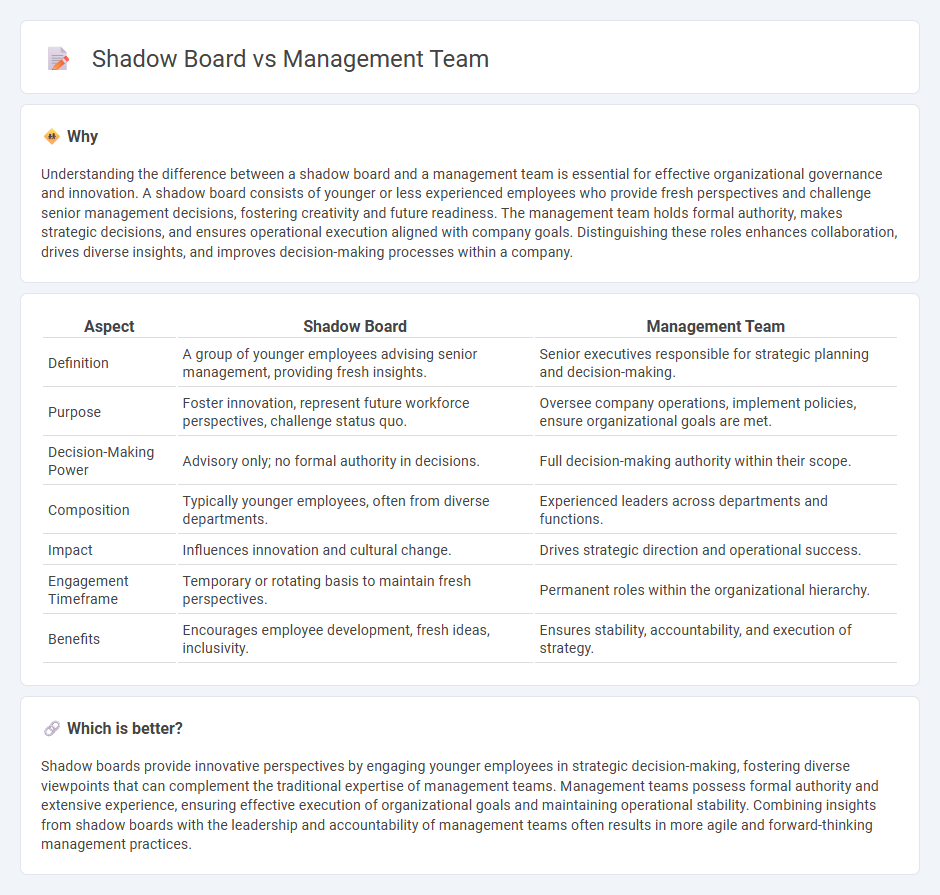
Shadow boards consist of emerging leaders who provide fresh perspectives and innovative ideas, complementing the traditional management team responsible for strategic decision-making and operational oversight. Management teams rely on experience and organizational knowledge to drive company goals, while shadow boards focus on challenging the status quo and fostering agility within the business. Discover how integrating shadow boards with management teams can enhance leadership effectiveness and drive transformative growth.
Why it is important
Understanding the difference between a shadow board and a management team is essential for effective organizational governance and innovation. A shadow board consists of younger or less experienced employees who provide fresh perspectives and challenge senior management decisions, fostering creativity and future readiness. The management team holds formal authority, makes strategic decisions, and ensures operational execution aligned with company goals. Distinguishing these roles enhances collaboration, drives diverse insights, and improves decision-making processes within a company.
Comparison Table
| Aspect | Shadow Board | Management Team |
|---|---|---|
| Definition | A group of younger employees advising senior management, providing fresh insights. | Senior executives responsible for strategic planning and decision-making. |
| Purpose | Foster innovation, represent future workforce perspectives, challenge status quo. | Oversee company operations, implement policies, ensure organizational goals are met. |
| Decision-Making Power | Advisory only; no formal authority in decisions. | Full decision-making authority within their scope. |
| Composition | Typically younger employees, often from diverse departments. | Experienced leaders across departments and functions. |
| Impact | Influences innovation and cultural change. | Drives strategic direction and operational success. |
| Engagement Timeframe | Temporary or rotating basis to maintain fresh perspectives. | Permanent roles within the organizational hierarchy. |
| Benefits | Encourages employee development, fresh ideas, inclusivity. | Ensures stability, accountability, and execution of strategy. |
Which is better?
Shadow boards provide innovative perspectives by engaging younger employees in strategic decision-making, fostering diverse viewpoints that can complement the traditional expertise of management teams. Management teams possess formal authority and extensive experience, ensuring effective execution of organizational goals and maintaining operational stability. Combining insights from shadow boards with the leadership and accountability of management teams often results in more agile and forward-thinking management practices.
Connection
A shadow board consists of younger employees who collaborate with the management team to provide fresh perspectives and innovative ideas on strategic decisions. This connection enhances organizational agility by integrating diverse viewpoints into traditional management processes. Engaging a shadow board fosters mentorship opportunities while aligning future leadership with current corporate goals.
Key Terms
Decision-making authority
The management team holds formal decision-making authority, responsible for executing strategies, managing operations, and ensuring organizational goals are met through their delegated powers. In contrast, a shadow board serves as an advisory or consultative group, often composed of younger employees or non-executive members, providing fresh perspectives and innovative ideas without formal authority. Explore the distinct roles and impact of management teams versus shadow boards in corporate governance.
Generational perspectives
Management teams traditionally reflect hierarchical decision-making shaped by experienced leaders, while shadow boards incorporate younger generations offering fresh, innovative insights aligned with emerging market trends. Shadow boards leverage millennial and Gen Z perspectives to challenge conventional strategies, fostering agility and digital transformation within organizations. Explore how integrating generational diversity in leadership structures can drive sustainable business success.
Strategic influence
The management team holds formal decision-making authority and is responsible for executing strategies that drive organizational growth and performance. In contrast, a shadow board serves as an advisory group, often composed of younger or diverse employees, providing fresh perspectives and strategic insights to influence long-term innovation and adapt to emerging market trends. Explore how integrating a shadow board can enhance strategic influence alongside traditional management structures.
Source and External Links
What are Management Teams? - A management team consists of top managers who oversee daily operations and set strategic direction, often working closely with the CEO to ensure effective leadership across different functions of the organization.
What Are Management Teams? - Management teams are groups of high-level associates responsible for essential business functions, including executive roles such as CEO, CFO, CMO, and COO.
What is a Management Team? - A management team is a collection of top managers who set strategy and run operations, meeting frequently to align with the organization's goals under the leadership of the top executive.
 dowidth.com
dowidth.com